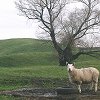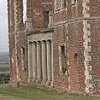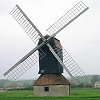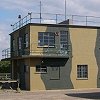Bedfordshire
Archaeology - General
Places > Bedfordshire > Archaeology
Places to Visit
Bedfordshire has been inhabited by human beings from the earliest times. A temporary camp of hunter-gatherers dating back to 125,000 - 70,000 years ago was found at Caddington and many tools and extinct animal remains have been found in the Bedfordshire river gravels.
The county has a number of interesting monuments that can be visited. Here is a selection.
Five Knolls Barrow Cemetery, Dunstable Downs
There are seven barrows in this group on Dunstable Downs. They are of different types and have been excavated by a number of archaeologists over the years including the renowned Mortimer Wheeler. Finds included cremation burials, animal bones, flints and arrow heads. The barrows were used throughout the Neolithic and Bronze Ages.
Discover more about Five Knolls Barrow
Galley Hill, Streatley
The remains of two barrows can be found on the summit of the hill. The initial Neolithic burials were followed by later activity which included a slaughter cemetery (fourth century) and gallows site (fifteenth century). A witchcraft deposit was made at the foot of the gallows that comprised a horse skull and dice.
Wauluds Bank, Luton
This is one of the most impressive field monuments in Bedfordshire with a massive bank, still over 2.5m in height. It was probably used as a settlement site in the Neolithic period and may also have been used as a henge monument (a prehistoric ritual site).
Maiden Bower, Houghton Regis
This circular enclosure was used with various modifications from the Neolithic to the Iron Age. It is thought that the site may have originally been a causewayed enclosure, a site that was used for meetings, religious festivals, trade and the like.
Disocver more about Maiden Bower
Sandy Lodge
There are three Iron Age enclosures in the area surrounding Sandy, Caesars Camp, Galley Hill and Sandy Lodge. Sandy Lodge is situated within the grounds of the RSPB nature reserve. It is a promontory fort consisting of a single rampart and ditch.
Sharpenhoe Clappers
This Iron Age hillfort was constructed with a wooden palisade and external ditch. The ramparts that can be seen on the site are likely to have been a medieval rabbit warren.
Bedford Castle
The mound of Bedford Castle originally constructed soon after the Norman Conquest of 1066 can still be seen clearly. The most notorious inhabitant of the castle was the Norman mercenary Faulkes de Breaute who terrorised the countryside for miles around until he was defeated in the siege of 1224 by Henry III.
Discover more about Bedford Castle
Cainhoe Castle, Clophill
The large earthwork remains of the castle of the dAubigny family can still be seen by the side of the A507. The motte and bailey castle was built in the late eleventh or early twelfth century. A deserted medieval village lies close to the site.
Discover more about Cainhoe Castle

Yielden Castle
This castle was built by the Norman Trailly family. The earthworks are well preserved and substantial. The castle originally seems to have comprised of a motte and bailey with surrounding fishponds. The castle was in ruins by 1361.
Conger Hill, Toddington
All that now remains of this castle site is a flat castle motte. It probably supported a timber structure during the reign of King Stephen.

Houghton House, Ampthill
Now in elegant ruins, this country house was originally built for Mary, Countess of Pembroke in 1615. The brick built house was designed as a hunting seat rather than a stately home and for this reason it is quite small. In 1738 the estate was purchased by the Duke of Bedford and was later dismantled by him.
Discover more about Houghton House

Stevington Windmill
This windmill is a fine example of Bedfordshires industrial archaeology and the only complete windmill in the county. This post mill was built in the 18th century and is still in working order. The mill was restored in 1951 by Bedfordshire County Council as part of the Festival of Britain celebrations.
Tempsford Airfield
This airfield is remembered for its associations with the work of the Special Operations Executive and others who were involved in the supply of war materials to the Resistance. Many agents were dropped into occupied territory from Tempsford including the under cover agent Violette Szabo G.C. A barn used for equipment during the war contains commemorative material and the runways can still be seen.
Discover more about Tempsford Airfield

Twinwoods Airfield, Clapham
Glenn Miller - the great American band leader - flew from Twinwoods Airfield in December 1944, never to be seen again. Visitors to the site can still see the Control Tower and various other World War Two buildings.
Finding out more
Museums
- The Higgins is the repository for all material from archaeological excavations in the north of the county. Highlights of the collections include a Celtic mirror from Old Warden, Roman treasures from Sandy and some of the earliest Saxon material in England from Kempston.
- Wardown Museum in Luton contains exhibits from the south of the county including the nationally important Shillington Roman coin hoard. The Luton Life galleries document the industrial and social life of the town over the last 150 years.
Libraries, Archives and other Organisations
- Bedford Central Library Local Studies Collection and Heritage Library houses the county local studies collection. Bedford Central Library has many local archaeological books and journals including the Bedfordshire Archaeological Journal and the Manshead Magazine. Other Bedfordshire Libraries hold material relevant to their local area.
- Bedfordshire has a number of thriving archaeological societies including the Ampthill and District Archaeological Society, the Bedford Archaeological and History Society and the Manshead Archaeological Society of Dunstable.
Bedfordshire Archaeology - Places to Visit, by Bedfordshire Libraries, 2008
Page last updated: 28th May 2020
